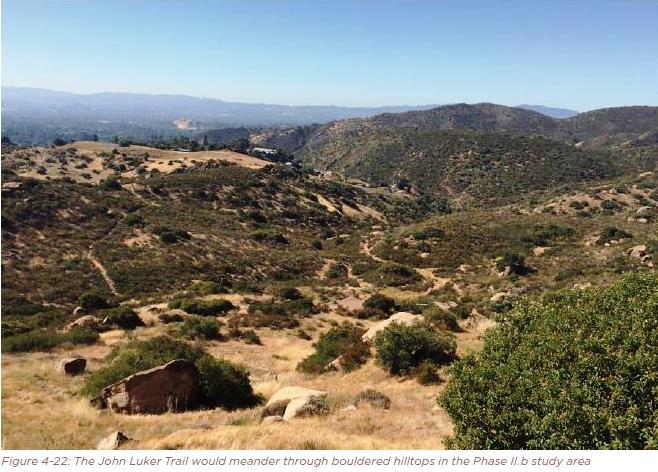
LA County Rec and Parks quietly plans hiking trails to contaminated Santa Susana Field Lab, ignoring toxins while honoring anti-cleanup gadfly
News & Analysis
Plans to build miles-long hiking trails leading to the Santa Susana Field Laboratory (SSFL) in west San Fernando Valley without full environmental review are quietly progressing, a month-long EnviroReporter.com investigation has found. This vetting failure ignores SSFL’s gross chemical and radioactive pollution.
The County of Los Angeles Department of Recreation and Parks’ plan, which involves two large parcels in unincorporated parts of the county, will come before the Board of Supervisors for final approval this spring. The area of concern is called “Phase II.b” which borders the lab, site of three partial nuclear reactor meltdowns which remains astronomically polluted.
Analysis of the scheme finds that it disregards toxic threats from the 2,850-acre former Rocketdyne site and contamination that has also been found in the proposed trails area. It also memorializes a longtime SSFL anti-cleanup gadfly with a new trail named in his honor and undermines Los Angeles County’s official position of demanding a full cleanup of SSFL.
Danger Zone
The county’s Santa Susana Mountains Trails Master Plan – Phase II calls for carving new walking, biking and horse riding paths into the hills downslope and bordering SSFL in Phase II.b’s 2-square-mile area. Bathrooms, staging areas, signage and a new 4.5 mile long trail adjacent SSFL are all part of the plan.
The unapproved proposal violates protocols of the California Environmental Quality Act (CEQA) by not disclosing potential environmental impacts of Phase II.b bordering SSFL which would connect new trails to ones already at the polluted site owned by Boeing. “The information collected informed the proposed trail network developed as part of the SSMTMP and CEQA process,” the report states, admitting its requirement to adhere to environmental laws.
Yet instead of making sure that possibly significant harmful impacts of building trails up to SSFL have been “avoided, reduced or minimized” to below significance, the county plan downplays the issue without analyzing it. The report, which totals hundreds of pages, sloughs off the lab’s toxins in just two sentences.
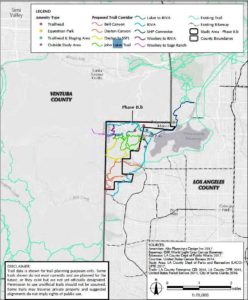
Comments on the plan submitted by this reporter advised that the proposed new trails should not be opened until completion of a full cleanup of SSFL. “All Dayton Canyon, Bell Canyon and Woolsey Canyon trail heads and staging areas should have warning signs to alert trail users of the potential dangers of chemicals in the soil, dust and water, much like the real estate warning given to nearby residents of the dangers of SSFL when property is purchased in the area.”
“No major cleanup has yet occurred though SSFL-owner Boeing has torn down some buildings as noted following,” this reporter wrote. “No ‘major cleanup’ will begin for at least two years in 2019, that is if there is any major cleanup at all as the lead state agency overseeing SSFL remediation is sabotaging its own cleanup as I reported recently in Toxics agency buries Santa Susana Field Laboratory cleanup – Fuzzy environmental impact report proposes leaving lab contamination in place as Boeing produces new greenwashing website against cleanup.”
The Trails Master Plan’s reference to Boeing’s controversial easement is perplexing given that representatives of LA County, Ventura County, and the LA City Council immediately objected to Boeing’s August 2017 announcement that the easement relieved it of its previous cleanup commitments, stating in a September 2017 letter that “Boeing’s attempt to reduce the level of clean-up to a much weaker standard will leave some of these toxicants in place, risking people’s health long into the future.” LA County Supervisor and Board Chair Sheila Kuehl has been a longtime advocate for full cleanup, weighing in as recently as December 6, 2017 with a letter to the Department of Toxic Substances Control (DTSC) urging full cleanup.
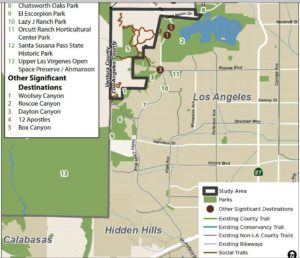
Community groups have decried Boeing’s easement as a thinly veiled attempt to get out of the cleanup, claiming that even if the site becomes open space, using recreational cleanup standards would leave most of the contamination on site where it will continue to migrate and threaten nearby communities. Comments from community members, elected officials, environmental and community organizations submitted on DTSC’s recent SSFL draft Environmental Impact Report (EIR) instead demand that the agency uphold its previous cleanup commitments to clean up all of the contamination at SSFL.
An August 2017 DTSC monthly update released October 3, 2017 tacked on an additional 17 years to the cleanup which was supposed to be completed this year. “Project cleanup schedules will be further defined in the remediation planning documents and associated designs, however if soil cleanup begins in early 2019, remediation of all chemically and radiologically impacted soils is anticipated to be completed by the end 2034,” said DTSC in the notice.
Trail of Jeers
EnviroReporter.com wasn’t the only SSFL watcher astonished at the incomplete CEQA for Phase II.b. Concerned environmental and nuclear policy groups weighed in also with little more than three days to analyze the trails master plan and comment. They included the Rocketdyne Cleanup Coalition, Committee to Bridge the Gap, Southern California Federation of Scientists and Physicians for Social Responsibility–Los Angeles, the latter of which is part of a coalition that won the Nobel Peace Prize this year for its nuclear policy work.
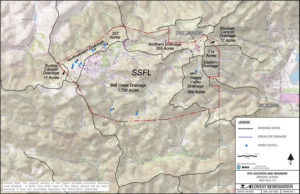
“CBG believes it would be imprudent to consider any trails in the areas near SSFL until the promised to background is complete,” commented SSFL watchdog Committee to Bridge the Gap. “Additionally, the County has been a vocal supporter of the promised cleanup to background. The parks department should be careful that it does nothing that can be used by the Responsible Parties (RPs) in support of their efforts to break out of their cleanup commitments, at variance with the County’s efforts to get full cleanup.”
Further infuriating SSFL cleanup proponents are county plans to name much of this trail system after a vocal opponent of the remediation, John Luker. Luker was first exposed as an SSFL polluter tool in 2012’s Boeing’s Meltdown Makeover series in Operation Astroturf and has reappeared as recently as 2017’s Brandeis-Bardin’s Toxic Denial.
“Additionally, we must candidly say that the proposal to name the trail leading up to SSFL the “John Luker Trail” is offensive to those of us who have worked for decades to get SSFL cleaned up, and we urge that it be reconsidered,” further commented RCC. “Mr. Luker is part of a group that was funded by one of the polluters of SSFL (which insisted that its funding be kept secret, leading to the resignation of at least one other member of the group). He has pushed for years the position of the parties responsible for the contamination, which is that the cleanup agreements the County and we have supported be abrogated and that large amounts of the contamination never be cleaned up. It is inappropriate to name a trail after such a person.”
Sleight of Land
A new comprehensive analysis by EnviroReporter.com has discovered that the Phase II.b plan reveals a comprehensive effort to mislead decision makers and the public about the proximity and potential hazards of SSFL to the bordering Phase II.b.
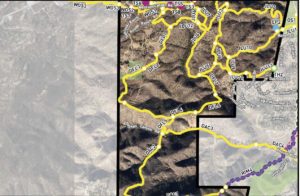
The planning team, headed by project manager Zachary Likins who began his new job as “park planner” for LA County in July 2017 according to Linked in, seemed to go even further than merely leaving information off of the Phase II.b maps. A figure on page 97 of Phase II.b’s mitigated negative declaration is called “Hazardous Sites within One-Eighth Mile of SSMTMP-PII Area” (see inset).

The very next page of the report does list SSFL twice in a hazardous sites table and called “Rockwell” as well as “Rockwell/Santa Susana Field Lb” [sic]. Both entries list the facilities’ “status” as “Open – inactive.” While the table’s designations are out of date (Rockwell sold SSFL to Boeing in 1996) and the status mystifying and false, it is clear the planners were aware of the place but chose to not include it in maps or any environmental assessment.
Ignoring the Goo
The decision to ignore SSFL’s looming presence over the Phase II.b area also ignores decades worth of contamination and health studies, news reporting, and an aware community the great majority of which demand that the site be cleaned up to strict standards agreed to in 2007 and 2010. In addition to the strong outpouring of support for full cleanup generated in response to DTSC’s EIR for the cleanup, over 130,000 people have signed a cleanup petition launched by families of pediatric cancer near SSFL. Beyond blowing off this information, county planners have failed to fulfill the project’s CEQA analysis, content to issue the following statement instead:
“The proposed project would result in no impact regarding having environmental effects which will cause substantial adverse effects which will cause substantial adverse effects [sic] on human beings, either directly or indirectly,” concluded county trail planners. “Potential environmental impacts associated with the proposed project in regard to human health and safety during construction, operations, and maintenance would be less than significant.”
Yet the contamination that has come down from SSFL through the Phase II.b area has been staggering. It also has been reported on extensively yet none of this information was included in the report.
In 2003, Los Angeles CityBeat reported that “a reading of 17ppb [of perchlorate] draining from Rocketdyne into Happy Valley, a drainage outlet that leads down into the San Fernando Valley through Dayton Creek.” The center of Phase II.b is Dayton Canyon, which includes the creek.
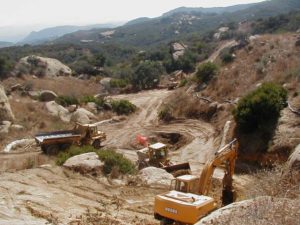
The 2004 newspaper story Two Mile Island reported that “69 million gallons of discharges, from SSFL rocket engine tests alone, go down Dayton and an adjacent creek every year.” Two years later, a UCLA study said that “there is potential for offsite chronic exposures within 1-2 miles of SSFL which includes, but is not limited to TCE emissions from SSFL-activities via inhalation in West Hills, Bell Canyon, Dayton Canyon, and Simi Valley,” as well as “hydrazine (and oxidation product NDMA) via inhalation of emissions from SSFL in Bell Canyon and West Hills.”
“Around 118 million gallons of Rocketdyne runoff pour into the Los Angeles River every year through Bell and Dayton canyons in Canoga Park,” EnviroReporter.com wrote in 2012. “The gushing goo prompted a $471,000 fine from the Los Angeles Regional Water Quality Control Board in 2007 for 79 pollution violations of it slushing into the river.”
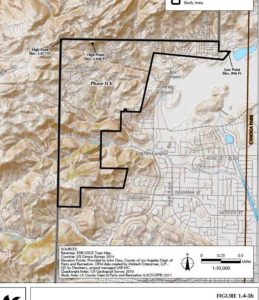
“One video shows heavy machinery in Area I of the lab roaring around destroying and grading the last of what once was the Instrument and Equipment Laboratories or IEL complex,” the EnviroReporter.com article said. “Huge clouds of dust are launched into the air landing on any SSFL subcontractors and full-time lab workers that may have been in the area as well as drifting towards the San Fernando Valley. Most of the contaminated dust falls out on hills that drain down Happy Valley above Chatsworth into Dayton Canyon Creek and finally the Los Angeles River.”
Has the untested Phase II.b area been impacted by this dust? And what exactly is in that dust?
“The IEL and the land around it are contaminated from decades of use of the toxins trichloroethylene, perchlorate, trichloroethane, hydrazine, perchloroethylene, hexavalent chromium, and heavy metals,” continued the article. “This dangerous dirt appears to have been blown all over the place by Boeing’s plainly sloppy procedures.”
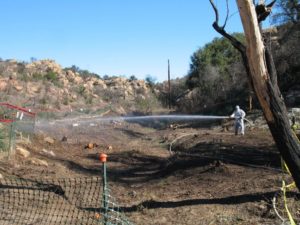
Contamination of SSFL is so severe “that the Congressional sponsors of the Rim of the Valley (ROV) legislation recently removed SSFL because of the contamination,” said Committee to Bridge the Gap in its comments. “The Phase IIb area proposal for trails and the associated Initial Study/Neg. Dec. completely ignore the contamination, as though it is not there. Ignoring it does not make it go away.”
Toasting the Trumping of Truth
The Los Angeles County Department of Parks and Recreation (DPR), which is responsible for Phase II.a and Phase II.b, held one meeting specific to each project area. The one devoted to Phase II.b attracted “approximately 10 attendees” in Woodland Hills April 18, 2017 according to the DPR trails master plan.
Not a single environmental group advocating for the cleanup of project-bordering Santa Susana Field Laboratory was contacted in any form that EnviroReporter.com could find. Most longtime neighborhood activists in both the San Fernando and Simi valleys were unaware of the project even though a few managed to comment on just three days’ notice.
John Luker’s name on a proposed new trail for Phase II.b may be the key to why the county’s planning department conveniently forgot about the SSFL’s menacing manifestation on the area’s western border. Luker is a director of the Santa Susana Mountain Park Association (SSMPA) and has spearheaded its anti-cleanup campaign of the lab. He has been part and parcel of Boeing’s greenwashing campaign, which absurdly claims that the cleanup will harm the environment when in fact the opposite is true – SSFL contaminants pose considerable risk to wildlife.
Likins presented the trail scheme at a SSMPA meeting October 16, 2017. “SSMPA board members, led by Dean Wageman and John Luker, are actively meeting and hiking with planners of the Los Angeles County Department of Parks and Recreation to provide input on the Santa Susana Trails Master Plan,” the event notice read. “SSMPA is providing assistance in mapping new trails in western LA County. SSMPA also wants to help in coordinating trail signage in the Chatsworth Hills with that of neighboring trails that pass into Ventura County, to maintain a cohesive style and placement that will make trail usage seamless and intuitive.”
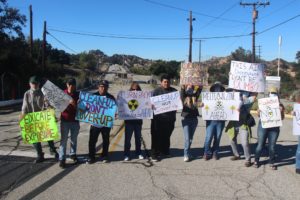
Demonstrations protesting the hikes through what a Rocketdyne official once called “Love Canal” have not proven an obstacle to Luker. The 2016 feature news piece Dept. of Energy secretly funding front group to sabotage its own Santa Susana Field Lab cleanup quoted Luker bragging of his Boeing connections and lack of concern for the toxic waste:
“In any case, I talked to Kamara [Sams, Boeing representative] earlier yesterday and they’re going to publish a map that shows where contamination is in the Southern Buffer Zone and what levels so people can see what they’re walking through,” Luker said without a trace of irony.
This clue as to Luker’s disregard for the toxins radiating from SSFL indicates haphazard county research and lack of sound science. Another master plan faux pas is a serious insult to Native Americans.
“The Gabrieleno Band of Mission Indians – Kizh Nation indicated that the project study area has a high level of sensitivity to potential tribal cultural resources, and that numerous sites are known within the project study area,” the Phase II.b mitigated negative declarations says. “The Tribe wishes to provide input on the trail naming.”
It is unlikely that these Native Americans were aware or approved of the longest Phase II.b trail being named after John Luker. Indeed, there is no indication of any public input into the naming of the proposed “John Luker Trail,” because if there had been, Likins and crew may have thought the better of it.
As EnviroReporter.com widely reported in 2016:
When people listen to Luker, they never know what will come out of his mouth other than knowing it will be infused with braggadocio and inflammatory nonsense. “[I]f you get three Indians in a room you’re going to have a fight,” Luker said at a January 21, 2013 meeting about the proposed Rim of the Valley National Park with Gary Polakovic and Bill Bowling in the audience. “Pretty much I’ve seen that to be true.”
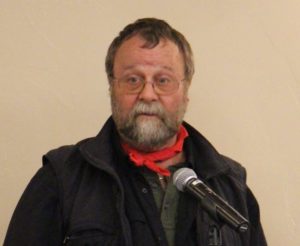
Luker even claimed that EnviroReporter.com actually wants to delay cleanup of SSFL for financial gain. “The two articles from the EnviroReporter are fake news!” Luker said in a November 28, 2016 Facebook comment. “They attack me personally so I have a good idea of their veracity… I’ve been attacked repeatedly by forces making money off of fear.”
In my Phase II.b comments, I made clear that it is Luker’s statements that lack veracity:
“The only danger John Luker is in is the possibility he’ll be sued for these kinds of libelous remarks. The real danger the community faces is if Luker’s anti-cleanup cabal succeeds in derailing the cleanup of the old Rocketdyne lab. Adding his name to a trail does not seem like wise policy and should be reversed.”
Trail’s End
The County of Los Angeles’ trail planners know all of this information now formally. Much of this material was submitted in this reporter’s comments. When Likins and fellow planners release their adjusted Trails Master Plan, it will hopefully shelve the entire Phase II.b part of the proposal until SSFL is remediated to background. The larger Phase II.a part of the master plan near Santa Clarita doesn’t face these kinds of environmental threats and should be implemented.
Failing that, the public will have just one more chance this spring to address the Los Angeles Board of Supervisors to register their views. That is if they even know when the meeting will take place. [EnviroReporter.com will keep its readers informed of the date once it’s known.]
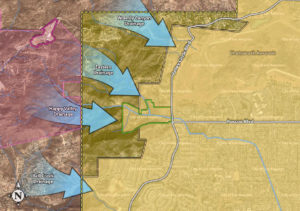
The plot to trail blaze a costly new path up to an unremediated SSFL is on track to become a permanent and potentially dangerous stain on the Los Angeles County Department of Parks and Recreation. In the process, trail planners would have sabotaged county efforts to make the polluters of SSFL clean up their goo to background and restore the place to its original splendor before becoming a sprawling Nazi-origin rocket testing compound.
LA can do better to protect its citizens and honor its past. In this case, it can save its money and save face by simply stopping this bold attempt to build trails in toxic terrain with no environmental studies. That would be a prudent decision for the people in both Los Angeles and Ventura counties.
25 Years of Award-Winning SSFL/Rocketdyne Reporting
1998 – 2023












There are other treatment methods – many that don’t contribute to the toxic trail that we uncovered [Editor – “we uncovered”?]. These include bioremediation (pumping biological agents, such as yeast, underground where they eat away at the toxic chemicals) and oxidation (which is like bioremediation, except that chemicals are pumped underground that break apart the hazardous stuff). the problem is that at many of these sites, it doesn’t matter what you do. In the end, it’s going to take centuries to get rid of the toxic chemicals. That’s because the chemicals aren’t just in the water, but in the surrounding ground soils. And when you take the toxic chemicals out of the water — in a process, that kind of works like osmosis — the chemicals from the soils seep into the water.
As a cancer survivor with multiple tumors removed and having a daughter with thyroid issues I cannot stress enough how many other people in West Hills and Simi Valley have died of cancer caused by the radiation they were exposed to from SSFL. Building trails there is a death sentence! Why would LA or Ventura intentionally kill it’s own people when California just passed a law banning smoking in the car with your own kids?!? This is all about making money. Developing up there without ANY clean-up!!
This is an EnviroReporter.com response to a March 1 piece in the Sierra Star featuring the very same John Luker in Toxic Trails. We take the author to task over leaving out pertinent details about Luker who is portrayed by the newspaper as an acorn planter who is “very respectable of our environment” [sic]:
Apparently Tony Krizan [in his March 1, 2018 Sierra Star piece “Could planting parties be a solution ahead?” ] is unaware of the extensive reportage done on John Luker III or he might have noticed EnviroReporter.com’s Feb. 6, 2018 exposé “Toxic Trails” where Luker’s true colors are shown once again. We wrote:
“Luker’s background leading hikes through still-heavily polluted SSFL is well documented as was shown in the 2016 exposé Critics question safety of Boeing’s Santa Susana Field Lab hikes. The ersatz Glow in the Dark Park ranger admitted proudly that he had taken over a thousand waiver-signing hikers, including kids, through the Southern Buffer Zone (SBZ) of SSFL that has tested positive for radium-226, plutonium-239/240, trichloroethylene (TCE), dioxins, PCBs, and perchlorate pollution. The SBZ border with the Phase II.b project area is little more than a barbed wire fence in the hills, hardly an anti-contamination barrier.”
And Luker himself with one of his many controversial utterances:
“In any case, I talked to Kamara [Sams, Boeing representative] earlier yesterday and they’re going to publish a map that shows where contamination is in the Southern Buffer Zone and what levels so people can see what they’re walking through,” Luker said without a trace of irony.
Krizan is right to laud oak tree acorn planting. He is wrong to ignore critical facts easily obtainable by a simple Google search for, say, ‘john luker ssfl’. Sierra Star readers deserve more.
I was diagnosed with a “golf ball sized”..meninginoma..It has as a main “explanation”exposure to radiation…I lived in Canoga Park 1959….I JUST found out about Rocketdyne..I used to watch Rocketdyne as a child…with its plumes from Calvert street…Are there any other kids from Enadia way Elementary School in 1959/…that have “brain tumors that want a class action lawsuit…People in Utah and Nevada have “ downwinder coverage…Why didn’t the San Fernando Valley get the same?….
Thank you Another Simi Mom, Lorraine Scott, Dale and Dorri for the excellent comments. Other comments not published here include a former newspaper editor of mine writing “More great work, Michael. This is koo koo. Unless you like hiking in Hazmat suits. I don’t find it that satisfying.”
What is satisfying is realizing that one of the best county-supplied maps of the Phase II.b scheme has been on the project’s webpage at Santa Susana Mountains Trails Master Plan – Phase II. It shows clearly the deliberate way Los Angeles County planners have erased the Santa Susana Field Laboratory in displaying the plan:
In Simi Valley we knew a popular man who moved to the community in 1970. At least twice a week he rode his horse up in the hills south of Fitzgerald Road and Royal Avenue. One of the places where he rode his horse was due south of Rocketdyne’s Area IV. During dry weather, if he rode fast, he would kick up the dust in those hills, covering him from head to toe. When he got home the dust would get all over the carpet, much to the consternation of his spouse who would be stuck with the vacuuming job. Little did he know that he might have been stirring up radioactive particles in addition to the dust. He died of cancer in 2006 from a type cancer which his physicians said was related to significant exposure to radioactivity.
As described by Enviroreporter in this article, Los Angeles County wants to build trails in the hills due east of Rocketdyne. Presumably those hills are “sprinkled with badness” from business operations which took place in the hills of nearby Ventura County between the 1950’s and the present. Boy Scouts, Girl Scouts, adventurous teenagers and TAXPAYERS will be walking those trails in perpetuity, as long as people reside in the San Fernando Valley. Los Angeles County will promote those trails to “outsiders” by advertising the County’s crown jewel, its network of trails running from Malibu to Santa Clarita and beyond. Some of those people will walk those trails, kicking up dust, once or twice a month because the trails will be accessed from residential neighborhoods in L.A. County and City. Possibly some of those trail walkers will get sick and die like our Simi Valley horse-riding friend did. Some of their doctors might even suspect that exposure to radiation was the cause of their illness.
Assuming that the family of each dead hiker consults a lawyer, the lawyer will focus on the legal doctrine explaining why Los Angeles County’s decision makers don’t give a shit now, and won’t give a shit in the future about dead hikers, including taxpayers. The doctrine is called “Sovereign Immunity”,
The Sovereign Immunity doctrine explains why L.A. County’s in-house lawyers have likely said to the Parks Department decision makers and the Board of Supervisors members “Don’t worry about health risks to the public from hiking trails we build.” Under the California Tort Claims Act, there is no personal injury liability for local government agencies or their elected decision makers and employees in the absence of specific language in a statute or constitutional provision expressly creating and assuming liability for the local government agency.
Under the California Government Code a county or city is not liable for personal injuries arising out of the discretionary choices made by a Board of Supervisors, a City Council or a public employee making management level project design decisions. The public employees and elected officials who made the discretionary decision are not personally liable for other people’s personal injuries when the public employees and elected officials have made discretionary decisions which have untoward consequences.
For example, in the San Fernando Valley there have been deadly Metrolink crashes over the years, some of them at street/track crossings that the National Transportation Safety Board has said were incorrectly designed under the NTSB’s at-grade crossing design safety standards. The cities responsible for the Valley’s unsafe at-grade street/track crossings have prevailed in California courts and walked away without spending a dime to reimburse injured commuter train passengers for medical treatment of their injuries after a crash at an intersection which is not up to NTSB safety standards.
In the case of a hiking or riding trail in the hills, the trail bed and surrounding landscape could be as “hot” as the woods surrounding Chernobyl but the County’s lawyers will say in sum and substance “The County is not liable for any illness or injury of the trail’s users arising out of exposure to radioactive substances, because the decision to build the trail in or near a hot zone is discretionary. Illustrating the discretionary nature of the County’s decision, the decision makers could have decided to build no trail at all. Or they could have decided to build the trail 5 miles away. Nobody legally compelled the County to build it.”
Yes personal injury plaintiffs lawyers can split hairs and if they are lucky get an elected trial judge to rule that the County’s decision to build a hiking trail near a radioactively contaminated site, or the County decision to fail to put up hazard warning signs at the beginning of the trail or along a creek is NOT discretionary. However history shows that when this sort of trial court decision goes up on appeal, the California Courts of Appeal and Supreme Court are likely to reverse it.
By and large if there is something “stinky” about management decision making by public employees in an L.A. County department like Parks or Regional Planning it is because some business interest has “gotten to” the senior public employees in that department. You can talk to lawyers and environmental activists who regularly litigate against Regional Planning. They will quote you chapter and verse about how the County departments’ decisions are affected by pressure from big businesses located in L.A. County.
Each member of the Los Angeles County Board of Supervisors is a king or queen in his or her District. Generally speaking, what a Supervisor wants they get, in terms of discretionary decision making by the Board and county employees about what is built or not built by the County in the Supervisor’s District.
At this juncture activists who do not want the public put at risk of illness by the building of the trails discussed in this article have one person they have to persuade to reject these trail locations: The L.A. County Board of Supervisors member in whose District these trails will be located.
But beware because discretionary decisions by individual Supervisors are often shaped by persuasion and threats from big businesses operating in the County. You’ll never hear or see that persuasion but you will hear and see evidence of it each time a controversial discretionary decision is made.
Fantastic article Michael! Well done! It makes my blood boil to hear what they are planning. It’s obvious they don’t care about the people this affects! Please keep us all informed as you always do. Without you the public would not know what these companies are trying to get away with! Thanks again Michael!
It would seem the public interest would be better served by clearly marking contaminated areas such as Dayton Canyon Creek instead of building access into them with new trails. Isn’t there potential future harm or liability by allowing and encouraging access to these areas without first cleaning them up and the SSFL sites that drain into them? A little common sense would seem the best course of action when it comes to public health and wildlife welfare. What is taking so long for decisive action to be taken. At least warning signs should be put in place, not a welcome mat complete with trail guides.
Thank you Michael for your excellent reporting. This is very upsetting to once again Boeing and its astrotrurfers are lying about safety and not planning to clean up this contaminated site, letting the public think that it is safe. The fact that not too many people know when the meetings are held.